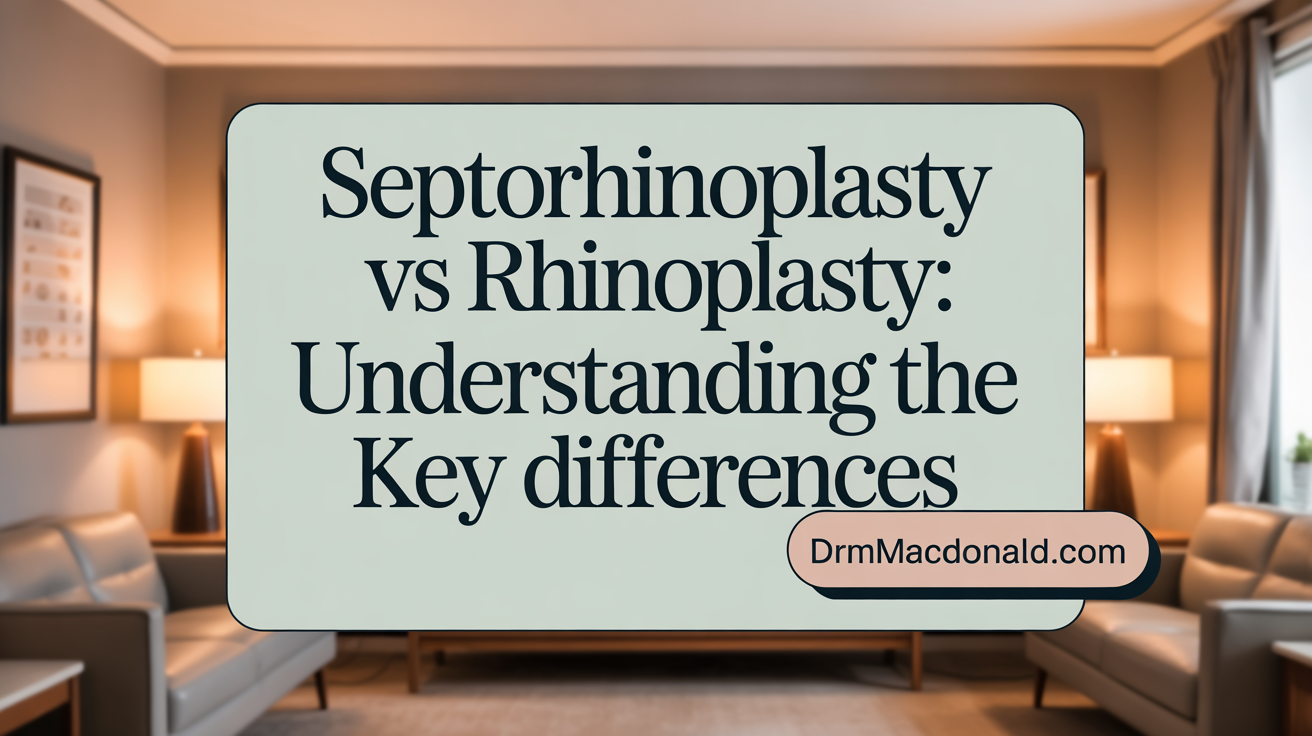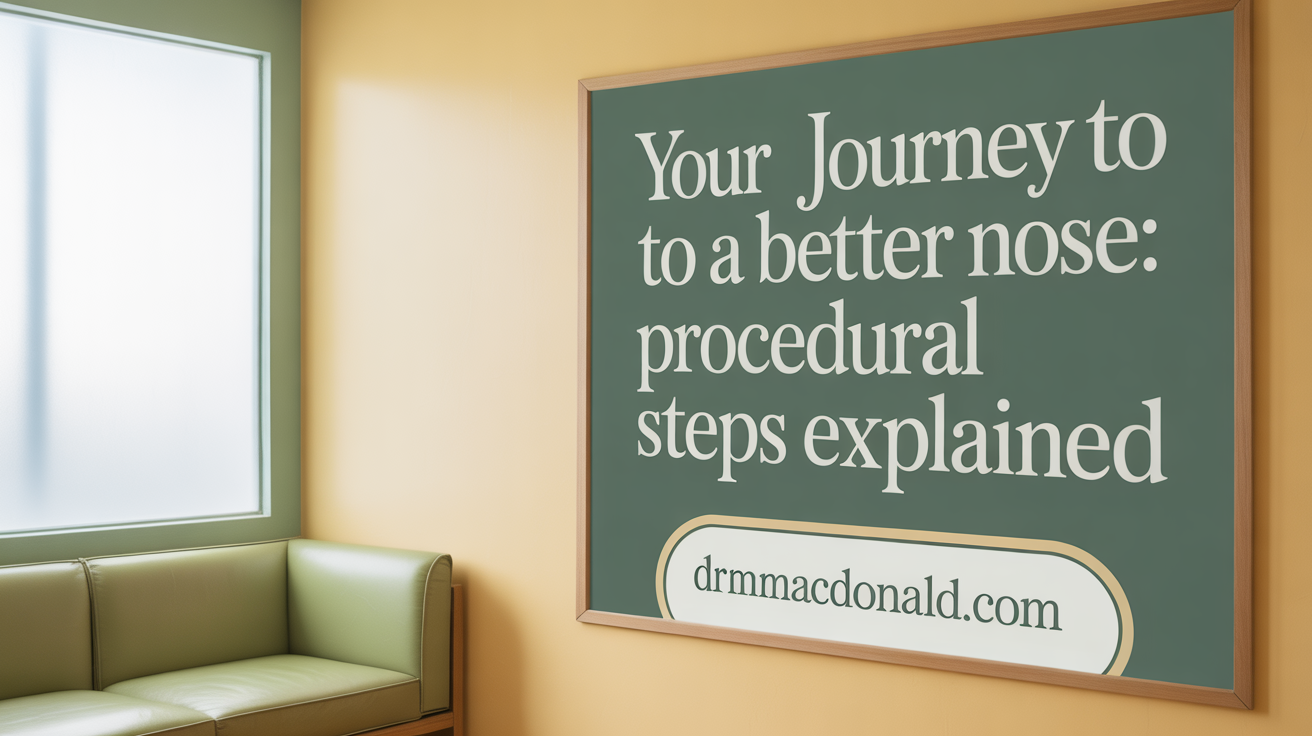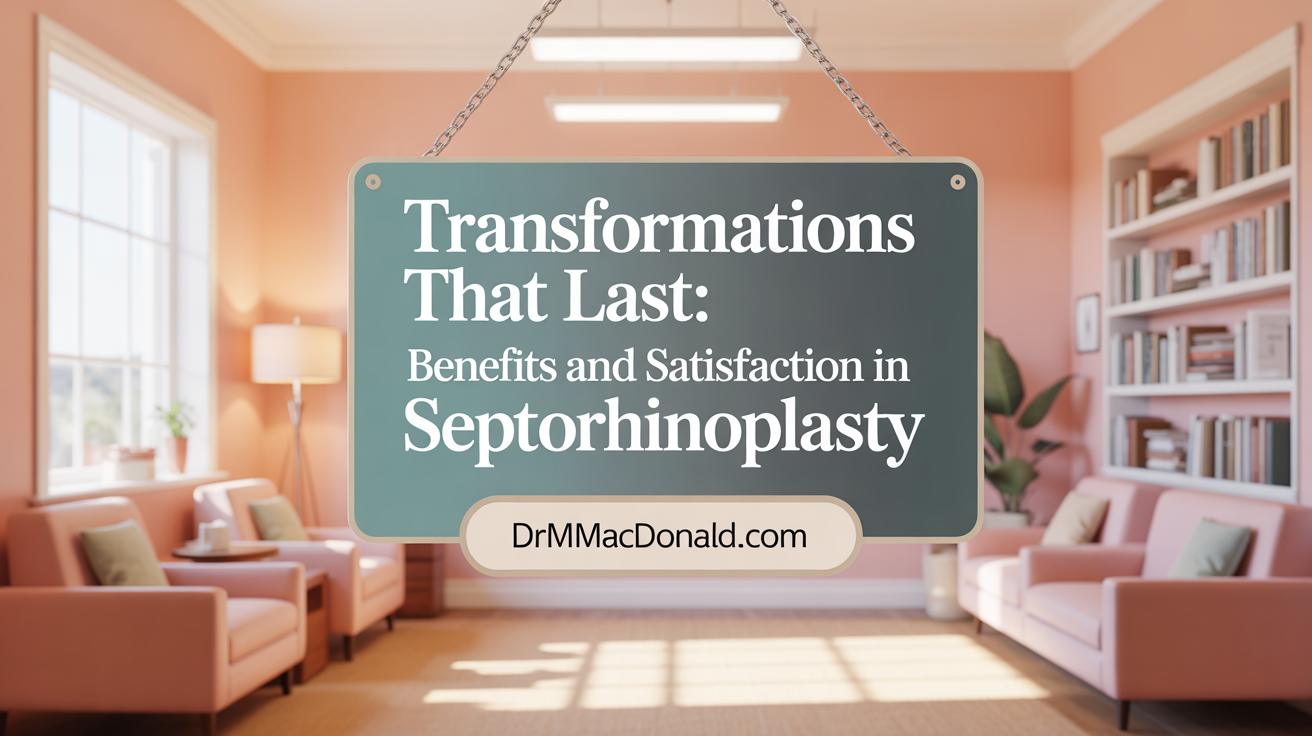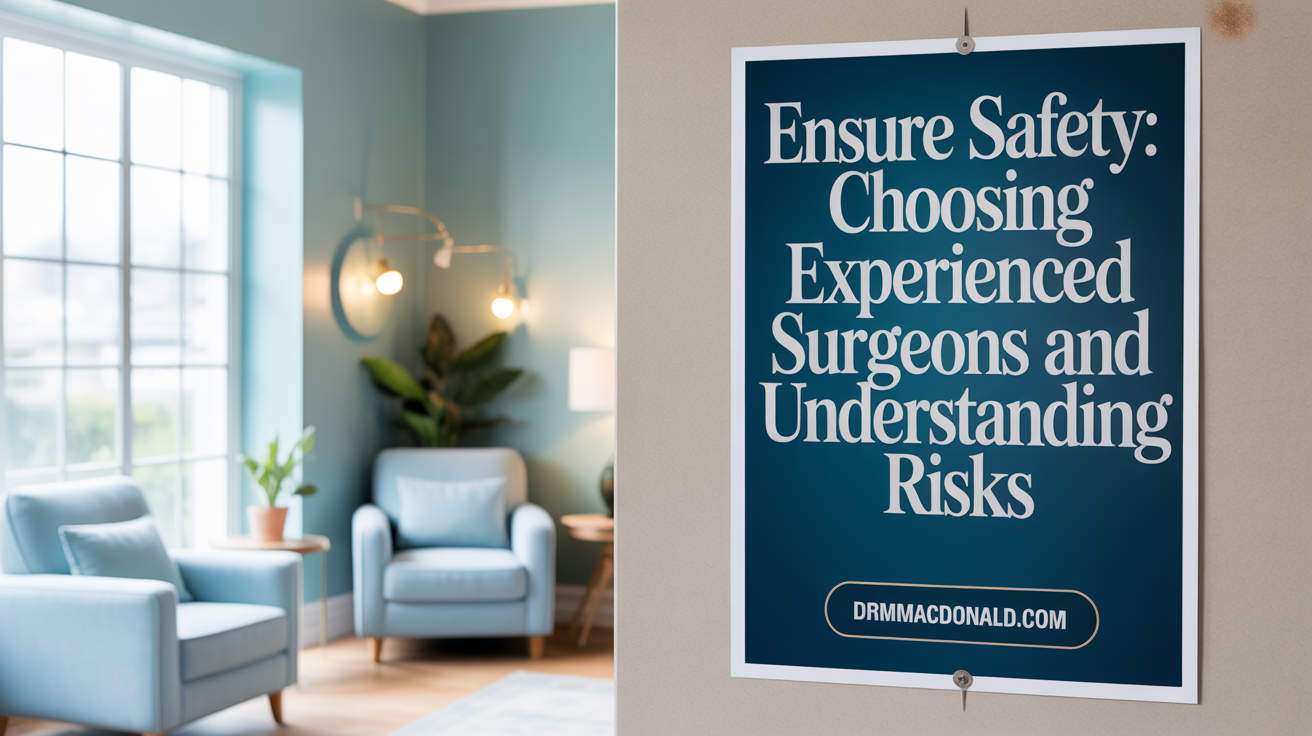Introduction to Septorhinoplasty
Septorhinoplasty is a specialized surgical procedure that simultaneously addresses both the functional and aesthetic aspects of the nose. By combining septoplasty and rhinoplasty techniques, this surgery aims to improve nasal airway function while refining the nose's external appearance. This comprehensive guide covers everything from candidacy and procedural steps to recovery, risks, and outcomes, providing patients with a detailed resource on what to expect from septorhinoplasty.
What is Septorhinoplasty and How Does It Differ From Rhinoplasty?

Definition of septorhinoplasty
Septorhinoplasty is a surgical procedure that combines two treatments: septoplasty and rhinoplasty. It aims to correct both the internal structure of the nose and its external appearance. The main goal is to improve nasal function, such as breathing, while also enhancing facial aesthetics.
Differences between septorhinoplasty and rhinoplasty
While rhinoplasty focuses solely on reshaping and resizing the nose for cosmetic purposes, septorhinoplasty includes addressing structural problems like a deviated septum. This internal correction helps improve airflow and relieve breathing issues. When both functional and aesthetic concerns are present, surgeons often perform septorhinoplasty, which benefits patients with nasal deformities or obstructions.
Functional vs cosmetic goals
The primary goal of septorhinoplasty is to improve nasal function, especially breathing, by correcting structural abnormalities like a crooked septum or narrow nasal passages. Cosmetic objectives include shaping the nose, reducing size, or fixing deformities, which can boost facial harmony.
Integration of septoplasty and rhinoplasty in one procedure
Performing both procedures together allows patients to address multiple concerns in one operation. This combined approach is more efficient and often results in less overall recovery time compared to having separate surgeries. It offers comprehensive improvements, harmonizing the nose's form and function, and providing a more natural and healthier result.
| Procedure Type | Focus | Typical Duration | Recovery Time | Common Indications |
|---|---|---|---|---|
| Rhinoplasty | Cosmetic reshaping | 1.5-3 hours | 1-2 weeks, final results up to 12 months | Facial appearance concerns |
| Septoplasty | Internal airway correction | 1-2 hours | Few days to 1 week | Breathing difficulties due to septum |
| Septorhinoplasty | Combined correction of form & function | 2-4 hours | 10-14 days, swelling up to 3 months | Both aesthetic and functional issues |
Indications, Candidate Criteria, and Alternatives for Septorhinoplasty
What are the common indications and criteria for qualifying for septorhinoplasty?
Septorhinoplasty is performed primarily to address both functional and aesthetic concerns of the nose. The most common reasons include a deviated septum causing nasal airway obstruction, which can lead to breathing difficulties, nasal congestion, or sleep disturbances. Structural deformities such as nasal fractures or congenital abnormalities can also warrant this surgery.
Candidates typically experience symptoms like persistent nasal blockage, snoring, or a visibly crooked nose that affects their appearance and breathing. The main qualifying criterion is the presence of a significant, symptomatic deviation or deformity that impacts nasal function.
To qualify for the procedure, candidates should be in good health and have completed facial growth—usually around age 18 or older—to ensure that their nose has fully developed. They should also have realistic expectations about what surgery can achieve, understanding that it can improve but not always perfectly restore nasal function or appearance.
Prior to surgery, a thorough preoperative evaluation is conducted. This includes a detailed medical history, physical examination, endoscopy of nasal structures, and sometimes imaging studies to assess the extent of deformity. These steps help determine whether septorhinoplasty is suitable or if alternative treatments should be considered.
Contraindications and alternatives to surgery
Certain factors can make septorhinoplasty unsuitable for some patients. Active sinonasal infections or uncontrolled allergies may require medical management before surgery. Substance abuse or unrealistic expectations can also be contraindications.
In cases where surgery isn't appropriate, nonsurgical options like nasal strips, medications (such as decongestants or antihistamines), and breathing exercises might provide temporary relief. However, these do not correct structural issues and are usually less effective for significant deformities.
In summary, septorhinoplasty is indicated when structural nasal problems cause functional impairment or aesthetic concerns. Proper patient selection through comprehensive evaluation ensures better outcomes and helps explore suitable alternatives for those who are not ideal surgical candidates.
Step-By-Step Procedural Overview of Septorhinoplasty

What procedural steps are involved in septorhinoplasty?
Septorhinoplasty is a combined surgical procedure aimed at correcting the structure and appearance of the nose. The process typically begins with administering anesthesia—either general anesthesia or local anesthesia with sedation—making sure the patient is comfortable and pain-free.
Once anesthesia is in place, the surgeon makes precise incisions inside the nose. These internal cuts are often called transfixion or marginal incisions. They provide access to the nasal septum and surrounding structures without visible external scars.
Next, the surgeon elevates mucoperichondrial and mucoperiosteal flaps. These temporary flaps lift the mucosal lining from the septum and nasal bones, exposing the cartilage and bone that need correction.
With the underlying structures visible, the surgeon corrects deviations or deformities. This may involve resecting or scoring cartilage and bone, removing or repositioning parts of the septum, and shaping these to improve function and symmetry. Care is taken to preserve the support structures, especially the L-strut—a vital component for nasal stability.
In many cases, especially when the nasal bones are displaced or crooked, osteotomies are performed. This involves carefully fracturing the nasal bones to allow realignment or narrowing of the nasal bridge. The bones are then moved into the desired position.
To enhance both form and function, grafts or implants might be used. These support the nasal tip, straighten the dorsum, or reinforce external valves affected by collapse or deformity.
Following the structural modifications, the surgeon meticulously closes the incisions with fine sutures, ensuring proper healing and minimal scarring.
Support is maintained during recovery by placing nasal splints and, sometimes, nasal packing—material that supports the septum and controls bleeding. External tapes might also be applied to stabilize the nose.
During postoperative care, splints are typically removed after about a week. Patients are advised to avoid strenuous activities and impacts on the nose to prevent shifting or injury. Regular follow-up ensures healing progresses properly and complications are addressed promptly.
In summary, septorhinoplasty involves a series of precise, carefully planned steps designed to improve nasal function and appearance, with each phase critical to the overall success of the procedure.
Recovery, Postoperative Care, and Managing Expectations
 The journey to healing after septorhinoplasty varies for each individual, but understanding the typical course can help set realistic expectations. Usually, patients experience an initial phase marked by swelling, bruising, mild discomfort, and nasal congestion that can last for several days to weeks.
The journey to healing after septorhinoplasty varies for each individual, but understanding the typical course can help set realistic expectations. Usually, patients experience an initial phase marked by swelling, bruising, mild discomfort, and nasal congestion that can last for several days to weeks.
During the first week, wearing a nasal splint is standard, which helps maintain the new shape of the nose. Patients might also notice nasal drainage and feel some discomfort, which can be managed with prescribed medications. Rest and keeping the head elevated are strongly recommended to reduce swelling and promote healing. Patients are advised to avoid blowing their nose, strenuous activities, or heavy lifting during this initial period to prevent complications.
Swelling and bruising tend to improve significantly within the first 2 to 4 weeks. Most patients are able to return to work and normal daily routines within one to two weeks, especially if their work is not physically demanding. However, it is important to remember that the final shape of the nose and the complete resolution of swelling take longer. Complete healing of nasal tissues and the attainment of final aesthetic results can take anywhere from 6 to 12 months.
Proper postoperative care plays a vital role in ensuring optimal healing. Using cold compresses can help reduce swelling, while nasal saline rinses keep the inside of the nose moist and clear of crusts. Avoiding smoking and alcohol, attending scheduled follow-up visits with the surgeon, and adhering to all care instructions are crucial for minimizing risks and complications.
While many can safely resume light activities in just a couple of weeks, patience is essential. Gradual improvements, both in appearance and breathing, continue over several months. Realistic expectations involve understanding that residual swelling, minor asymmetries, or changes may occur but typically resolve over time. This gradual process underscores the importance of following your surgeon’s advice for post-operative care to achieve the best possible final results.
Benefits, Outcomes, and Patient Satisfaction in Septorhinoplasty

What are the benefits and goals of septorhinoplasty?
Septorhinoplasty combines the correction of structural issues inside the nose with aesthetic improvements of the external nose. Its main goal is to straighten a deviated septum, which often causes breathing problems, nasal congestion, and sinus issues. By fixing these issues, patients typically experience better airflow, reduced snoring, and improved sinus health.
Besides functional benefits, septorhinoplasty also enhances the appearance of the nose. Reshaping procedures can correct asymmetries, bumps, or deformities, leading to a more harmonious facial balance. Many patients report increased confidence and self-esteem after the surgery.
The procedure can also increase exercise tolerance, reduce nasal-related headaches, and improve overall nasal health. In summary, septorhinoplasty aims to improve breathing, restore nasal structure, and boost personal confidence.
How does septorhinoplasty impact breathing and aesthetic appearance?
Functional improvements in breathing are often immediate, with many patients noticing easier nasal airflow right after surgery. Over several weeks, swelling decreases, further improving nasal function. Aesthetic enhancements involve reshaping the nose for a more proportionate look, often aligning the nose more harmoniously with other facial features. Outcomes depend on the surgeon’s skill, but most patients achieve natural-looking results.
Impact on quality of life and patient satisfaction rates
Patients usually experience a significant boost in quality of life following septorhinoplasty. Better breathing can lead to less fatigue, fewer headaches, and improved sleep quality. Satisfaction rates are high—most studies report over 90% of patients are happy with their results. This high satisfaction stems from both improved nasal function and aesthetic enhancements.
Expected postoperative results
Initial swelling and bruising are common in the first week, with most swelling subsiding in 2-3 weeks. Full healing, including residual swelling, can take up to a year. Patients are advised to avoid strenuous activities for several weeks and to follow specific post-op care instructions to ensure optimal healing. Progress in nasal function and appearance continues gradually, with improvements observed in stages: about 40% healing in six weeks and up to 70% in six months. Most patients report noticeable improvements in both breathing and aesthetics within the first few months, with final results becoming clear after a year. Overall, septorhinoplasty offers lasting benefits and high levels of patient satisfaction when performed by experienced surgeons and with proper aftercare.
Risks, Pain Management, and Selecting a Qualified Surgeon

What potential risks and complications are associated with septorhinoplasty?
Septorhinoplasty entails various risks, which can vary in severity. Common concerns include bleeding, infection, and nasal obstruction, especially if healing does not proceed as expected. More serious but rare complications include toxic shock syndrome, cerebrospinal fluid leaks, meningitis, and injury to blood vessels or the brain. Postoperative deformities, asymmetries, and loss of sensation or septal perforation may also occur. In about 5-15% of cases, revision surgery might be needed to correct unsatisfactory results or complications.
Many risks can be reduced through careful surgical planning, performed by an experienced surgeon, and thorough patient evaluation. Using precise techniques, minimizing trauma, and ensuring proper postoperative care are crucial in safe recovery. Patients should discuss all potential risks with their surgeon to make an informed decision.
How does the pain from septorhinoplasty compare to that from rhinoplasty?
Pain levels vary between these procedures. Septorhinoplasty generally causes milder discomfort that peaks within the first day after surgery. Since it involves less extensive manipulation of bone and cartilage, recovery tends to be quicker.
Rhinoplasty, which often includes more extensive reshaping of the nose’s structure, can lead to more pronounced pain that lasts several days. Patients often experience moderate discomfort, swelling, and bruising that may require stronger pain medication initially.
Overall, both procedures produce manageable discomfort, with rhinoplasty typically associated with slightly higher and longer-lasting pain levels. Patients can expect mild to moderate pain that diminishes within a week, depending on individual healing responses.
Why is surgeon experience and credentials important?
Choosing a qualified surgeon is vital for minimizing risks and achieving the best possible results. Experienced surgeons have specialized training and a deep understanding of nasal anatomy and surgical techniques. Their expertise reduces the chances of complications such as asymmetry, poor healing, or unsatisfactory aesthetic outcomes.
Board certification, a good track record, and patient testimonials are indicators of a surgeon’s skill. It’s recommended to review their previous work, discuss your goals thoroughly, and ensure they are experienced in both cosmetic and functional rhinoplasty if needed.
Highly qualified surgeons also follow strict safety protocols, customize procedures based on individual needs, and provide comprehensive pre-and post-operative care.
What about insurance and cost considerations?
Rhinoplasty can be costly, often reflecting surgeon expertise, complexity of the surgery, and geographic location. In the United States, the procedure may cost between $5,000 and $15,000.
Insurance typically covers septorhinoplasty if it addresses breathing or structural issues like a deviated septum, but not if it’s solely for cosmetic reasons. Documentation of breathing problems and functional impairments is essential for insurance coverage.
For those seeking affordable options, countries like Turkey offer more economical prices for medical tourism, with access to highly skilled surgeons. Always verify the credentials and safety standards if considering international clinics.
Are revision surgeries common?
Revision rhinoplasty is performed when initial results are unsatisfactory or complications occur. It’s needed in approximately 5-15% of cases and can address issues like residual deformities, breathing difficulties, or scar tissue formation.
Revision procedures can be more challenging due to altered anatomy and scar tissue. As such, choosing a highly experienced surgeon reduces the likelihood of needing revisions. Patients should have realistic expectations and discuss all concerns thoroughly before surgery.
| Aspect | Details | Additional Notes |
|---|---|---|
| Main risks | Bleeding, infection, breathing issues | Rare but serious risks include brain injury and cerebrospinal fluid leaks |
| Pain comparison | Septorhinoplasty: milder; Rhinoplasty: more intense | Pain peaks early and subsides within days; managed with medications |
| Surgeon importance | Expertise reduces complications | Board-certified, experienced in nasal surgeries |
| Costs and coverage | Varies widely; insurance covers functional issues | International options available for affordability |
| Revision surgery likelihood | 5-15%; depends on initial outcome | Requires skilled surgeon; more complex procedures |
Choosing a qualified, experienced surgeon and understanding potential risks are integral for a safe, satisfactory rhinoplasty experience. Proper preoperative planning, realistic goals, and thorough aftercare can make a significant difference in outcomes.
Conclusion: Achieving Functional and Aesthetic Harmony with Septorhinoplasty
Septorhinoplasty is a multifaceted surgical solution designed to relieve nasal airway obstruction while enhancing the nose’s appearance, perfectly suited for patients facing both functional and cosmetic nasal challenges. With careful candidate selection, meticulous surgical technique, and thorough postoperative care, the procedure offers significant benefits in breathing improvement and facial aesthetics. Understanding the risks, setting realistic expectations, and choosing a skilled, qualified surgeon are critical to achieving satisfactory outcomes. Patients are encouraged to consider this comprehensive approach for a balanced restoration of nasal function and form, supporting both physical health and emotional well-being.
References
- Rhinoplasty (Nose Job): Surgery, Recovery, Before & After
- Functional Rhinoplasty
- The Houston Guide to Septorhinoplasty Surgery | Dr. Angela Sturm
- [PDF] Rhinoplasty and septorhinoplasty - HealthPartners
- Septorhinoplasty: Enhance Breathing & Looks - Care in Turkey
- Should I Get Rhinoplasty? A Complete Guide with Everything You ...
- Everything You Need to Know About Rhinoplasty: A Complete Guide
- Clinical Practice Guideline: Improving Nasal Form and Function after ...
- Rhinoplasty Surgery: A Complete Guide to Nose Reshaping
